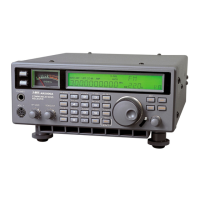AR5000 OPERATING MANUAL PAGE 1
Contents
(1) Table of contents .......................................................................... 1
(2) Introduction ................................................................................... 2
2-1 Key information and common menus .................................. 3
2-2 Accessories supplied .......................................................... 4
(3) Major Features .............................................................................. 4
(4) Precautions ................................................................................... 4
4-1 Location .............................................................................. 4
4-2 Looking after your receiver ................................................... 5
4-3 Power requirements ............................................................ 5
4-4 Aerial (antenna) connection ................................................. 5
(5) Controls and functions ................................................................ 6
Front panel
5-1 On/Off power switch ............................................................ 6
5-2 S-meter (signal strength meter) ........................................... 6
5-3 Liquid Crystal Display (LCD) ................................................ 6
5-4 Main (large) rotary tuning control - MAIN DIAL .......................... 8
5-5 Sub (small) rotary tuning control - SUB DIAL ............................ 8
5-6 Torque adjustment (MAIN DIAL brake) ..................................... 8
5-7 Removable feet ................................................................... 9
5-8 Internal speaker .................................................................. 9
5-9 SQ - squelch control (plus RF control) ................................. 9
5-10 Volume control (AF GAIN) ................................................. 10
5-11 ACC 1 accessory number one socket ................................ 10
5-12 Headphone socket ............................................................. 10
5-13 Front panel keys ................................................................ 10
Rear panel
5-14 DC 12V - external power connection .................................. 15
5-15 ACC 2 (accessory 2 socket) ............................................. 15
5-16 EXT SP - external speaker output socket ........................... 16
5-17 REMOTE - RS232C computer control port ........................ 16
5-18 I.F. OUTPUT (10.7 MHz) ................................................... 16
5-19 STD IN (10 MHz) ............................................................... 16
5-20 MUTE ............................................................................... 16
5-21 ANT 2 ............................................................................... 17
5-22 ANT 1 ............................................................................... 17
(6) Basic manual operation of the receiver ..................................... 17
6-1 Switching on for the first time .............................................. 17
6-2 Changing VFO .................................................................... 17
6-3 Tuning the receiver using the rotary controls ........................ 18
6-4 Entering a frequency via the numeric keypad ....................... 18
6-5 Correction of frequency input via the numeric keypad ........... 19
6-6 Selecting tuning step (increment) ......................................... 19
6-7 Step-adjust .......................................................................... 20
6-8 FREQUENCY OFFSET ....................................................... 22
6-9 Changing receive mode (AUTOMODE) ................................ 22
6-10 IF BANDWIDTH ................................................................ 24
6-11 AF SET - (Audio characteristics) ........................................ 25
6-12 Audio tone eliminator (T-ELMT) ......................................... 27
6-13 DTMF decoder .................................................................. 28
6-14 RF Attenuator & preamplifier ............................................. 28
6-15 CONFIG menu outline of facilities ...................................... 28
6-16 CONFIG - LAMP ............................................................... 29
6-17 CONFIG menu - BEEP ..................................................... 29
6-18 CONFIG - EXTERNAL I.F. output (SDU5000) ..................... 29
6-19 CONFIG - Computer control BPS ....................................... 29
6-20 CONFIG - Advanced aerial switching .................................. 30
6-21 CONFIG - Frequency standard ............................................ 32
(7) Memory banks & channels ............................................................ 33
7-1 Storing receive data into memory - VFO mode ...................... 33
7-2 Memory recall - Recalling receive data from memory ............. 34
7-3 Transfer of memory channel to VFO ...................................... 35
7-4 Changing and deleting memory data ..................................... 35
7-5 Deleting memory channels and banks ................................... 36
(8) SCAN - scanning memory channels & banks ............................. 37
8-1 SCAN - outline introduction to facilities available ................... 37
8-2 Starting to SCAN, considerations .......................................... 37
8-3 SCANNING a memory bank ................................................. 38
8-4 Selecting a single memory bank to scan ................................ 38
8-5 Memory bank linking to scan ALL memory banks .................. 39
8-6 Specifying memory bank linking ............................................ 39
8-7 Scanning a memory bank which is not linked ........................ 39
8-8 SCAN channel PASS (lockout) .............................................. 40
8-9
Cyber Scan
in SCAN mode .................................................. 41
(9) Additional SCAN facilities ............................................................. 41
9-1 SCAN - PAUSE .................................................................... 41
9-2 SCAN - DELAY .................................................................... 42
9-3 SCAN - LEVEL SQUELCH ................................................... 42
9-4 SCAN - VOICE ..................................................................... 42
9-5 SCAN - MODE (receive mode AM, FM etc) ........................... 43
(10) SELECT SCAN - special
select scan list
overview ................... 43
10-1 Tagging scan select channels .............................................. 43
10-2 SELECT SCAN - while in SCAN MODE .............................. 44
10-3 SELECT SCAN while in MEMORY RECALL mode ............. 44
10-4 Starting SELECT SCAN ..................................................... 44
10-5 Deleting all SELECT SCAN channels in one go ................... 44
(11) Priority operation .......................................................................... 45
11-1 Engaging PRIORITY channel .............................................. 45
11-2 Changing PRIORITY channel parameters ............................ 45
(12) SEARCH ......................................................................................... 46
12-1 Manual SEARCH between two VFO frequencies (VA, VB) ... 46
12-2 Simple search (VC, VD, VE) ............................................... 47
12-3 Optimising VFO search parameters ..................................... 48
12-4 Program search banks ........................................................ 49
12-5 Starting program search ...................................................... 50
12-6 Cancelling, restarting program search ................................. 50
12-7 Programming and reprogramming SEARCH BANKS .......... 51
12-8 Deleting PROGRAM SEARCH BANKS ............................... 53
12-9 SEARCH - outline introduction to additional facilities ........... 53
12-10 Linking program search banks ........................................... 54
12-11 Linking only a few search banks ......................................... 55
12-12 Searching a bank which is not selected in BANK LINK ...... 55
12-13 Additional PROGRAM SEARCH facilities (introduction) ..... 55
12-14 PROGRAM SEARCH - PAUSE ......................................... 55
12-15 PROGRAM SEARCH - DELAY ......................................... 56
12-16 PROGRAM SEARCH - LEVEL SQUELCH ....................... 56
12-17 PROGRAM SEARCH - VOICE ......................................... 57
12-18
Cyber Search ................................................................... 57
12-19 AUTO-STORE .................................................................. 58

